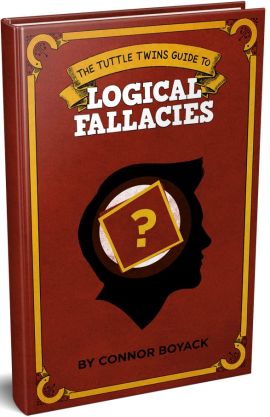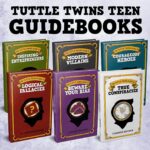save
$4.00The Tuttle Twins Guide to Logical Fallacies (Connor Boyack)
$15.99$19.99
In a society where countless ideas are being shared, debated, and analyzed, it’s more important than ever to sift out the good ones from among the bad ones. And when people you respect and trust use arguments that sound persuasive, how can you determine if they are correct?
One of the most commonly used methods of spreading misinformation is the use of a logical fallacy—a bad argument that makes something seem truthful that actually might not be. These types of arguments are used repeatedly, and there are many different types.
Fortunately, these logical fallacies can be learned, so they can be avoided. Armed with this information, you’ll be equipped to understand when people are sharing an idea that is wrong or making a claim that isn’t true. You’ll become an expert debater by being able to point out a flaw in an opponent’s argument.
That makes this book dangerous—a guidebook for teenagers and young adults who want to explore the ins and outs of how to win arguments and point out problems in others’ ideas. Use this book wisely!
Out of stock
The Tuttle Twins Guide to Logical Fallacies
In a society where countless ideas are being shared, debated, and analyzed, it’s more important than ever to sift out the good ones from among the bad ones. And when people you respect and trust use arguments that sound persuasive, how can you determine if they are correct?
One of the most commonly used methods of spreading misinformation is the use of a logical fallacy—a bad argument that makes something seem truthful that actually might not be. These types of arguments are used repeatedly, and there are many different types.
Fortunately, these logical fallacies can be learned, so they can be avoided. Armed with this information, you’ll be equipped to understand when people are sharing an idea that is wrong or making a claim that isn’t true. You’ll become an expert debater by being able to point out a flaw in an opponent’s argument.
That makes this book dangerous—a guidebook for teenagers and young adults who want to explore the ins and outs of how to win arguments and point out problems in others’ ideas. Use this book wisely!
The List of Fallacies (Table of Contents)
- The Strawman
- False Cause
- Appeal to Emotion
- Slippery Slope
- Ad Hominem
- Personal Incredulity
- Special Pleading
- Loaded Question
- Burden of Proof
- Ambiguity
- The Gambler
- The Bandwagon
- Appeal to Authority
- Composition & Division
- No True Scotsman
- Origins
- Black or White
- Begging the Question
- Appeal to Nature
- Anecdotal
- The Sharpshooter
- Middle Ground
- Tu Quoque
- The Fallacy Fallacy
About the Author
Connor Boyack is president of Libertas Institute, a free market think tank. In that capacity, he has spearheaded a number of successful policy reforms in areas such as education reform, civil liberties, government transparency, business deregulation, personal freedom, and more.
Connor has published 22 books and sold over 1.5 million copies. His The Tuttle Twins series for children introduces young readers to economic, political, and civic principles.
Illustrated by Elijah Stanfield
| Weight | 0.64 lbs |
|---|
You may also like…
-
The Tuttle Twins Guidebook Combo Set (Connar Boyack)
$83.95These hardback non-fiction books teach pre-teens and teenagers (and adults!) about important topics like logical fallacies, critical thinking, entrepreneurship, and standing up for what is right!
$119.94










